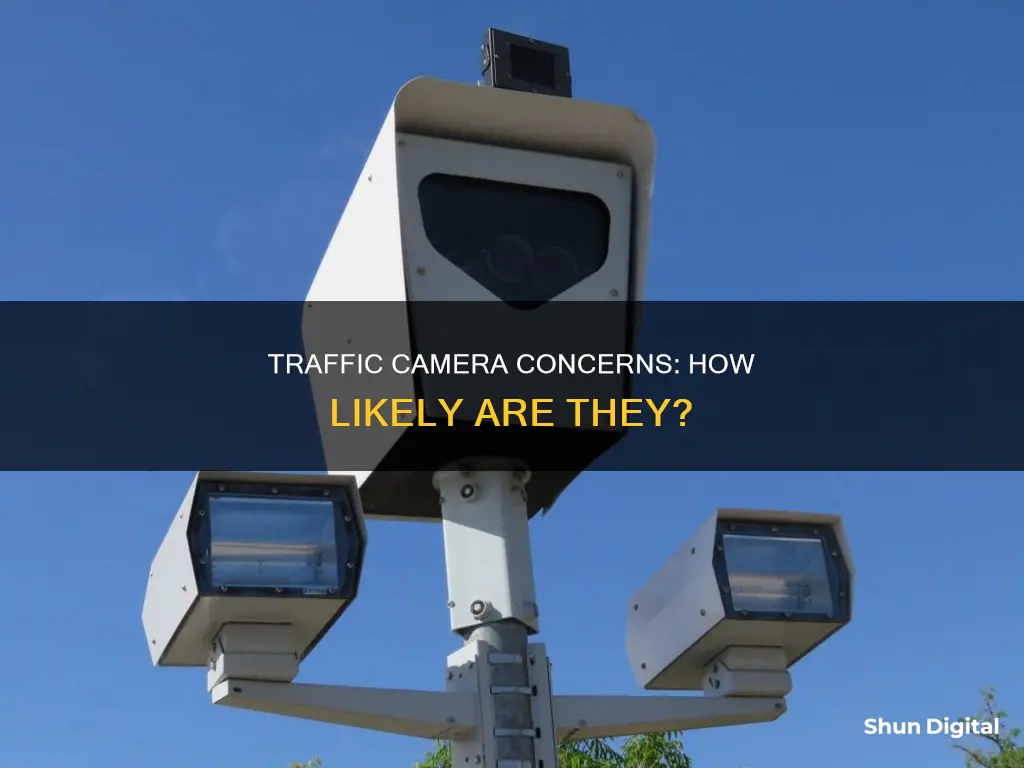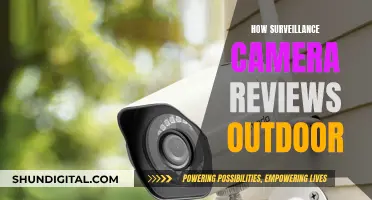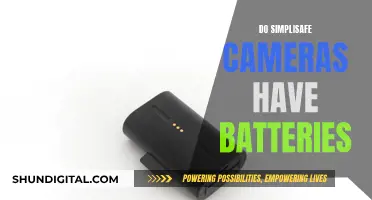
Traffic cameras are a common feature on roads and intersections, and they serve various purposes, including monitoring traffic speeds and conditions, enforcing traffic rules, and tracking vehicles. Red light cameras, for instance, are placed at busy intersections to detect motorists entering on a red light, while speed cameras are often found on less populated back roads and residential areas to monitor speeding violations. With advancements in technology, these cameras have become more sophisticated, combining artificial intelligence to read license plates and track drivers' whereabouts. While some people appreciate the safety measures provided by these cameras, others view them as an invasion of privacy and government overreach.
| Characteristics | Values |
|---|---|
| Purpose | Monitoring traffic patterns, enforcing road safety, issuing tickets, tracking the locations of certain vehicles and drivers, etc. |
| Location | Highways, freeways, expressways, arterial roads, traffic lights, intersections, etc. |
| Power Sources | Mains power, solar panels, or other alternative power sources |
| Camera Type | Video cameras, still cameras, analog cameras, high-definition cameras, 4K resolution cameras, etc. |
| Mounting | Mounted on poles, traffic lights, street lights, or vehicles |
| Privacy Concerns | Yes |
What You'll Learn

Red light cameras are automated ticket-issuing systems
Red light cameras are typically bulky and consist of a large box with two external flashlights mounted on each end of an intersection. They are usually placed 10 to 15 feet off the ground and are often positioned separately on poles. They are also distinguishable by their location, always near a busy intersection.
Red light cameras are not the same as traffic cameras, which are typically smaller and placed on top of traffic lights or signals to monitor traffic flow and help determine the lights' timing. They do not take pictures of vehicles running red lights or issue citations.
Red light cameras are also different from speed cameras, which are similar in concept but are used to detect speeding violations. Speed cameras are usually placed in less populated areas such as back roads or residential areas.
In some jurisdictions, a notice of violation may be sent to the owner of the vehicle, requesting identifying information so that a ticket can be issued later. In other jurisdictions, a fine may be assessed to the owner of the vehicle, who is then responsible for collecting the fine from the offending driver.
It is important to note that red light cameras do not issue moving violations or criminal charges. From a legal standpoint, they are considered administrative violations, similar to parking tickets. As a result, drivers do not have the right to face their accuser in court. However, drivers have the right to challenge the citation if they believe it was issued in error.
Reversing Car Cameras: Hardwiring for Safety and Peace of Mind
You may want to see also

Speed cameras monitor speed and enforce limits
Speed cameras are an effective way to monitor speed and enforce speed limits. They are placed in high-risk locations such as tunnels or areas with a history of severe crashes. They are also installed at sites that meet specific criteria, including crash rates and travelling speeds.
Speed cameras are proven to deter drivers from speeding, thereby reducing crashes and preventing deaths and injuries. A worldwide review of studies found that speed cameras led to an 11% to 44% reduction in fatal and serious injury crashes. The UK Department for Transport estimated that cameras led to a 22% reduction in personal injury collisions and 42% fewer people being killed or seriously injured at camera sites.
There are two types of speed cameras: fixed and mobile. Fixed speed cameras are mounted on elevated poles at the side of the road and are easy to spot due to their bulky weatherproof enclosures and external flashes. Mobile speed cameras, on the other hand, are more challenging to notice as they are not permanently mounted and can be placed on a tripod or inside a van.
Speed cameras use various technologies to detect speed, including Doppler radar, LIDAR, stereo vision, or automatic number-plate recognition. They accurately measure the speed of a vehicle, and if it exceeds the legal limit, a digital picture is taken of the offending vehicle, along with details such as the location, direction of travel, speed, and lane information.
The use of speed cameras is controversial, with some arguing that they invade privacy and are used for revenue generation rather than improving road safety. However, the effectiveness of speed cameras in reducing crashes and saving lives is well-documented, and they are supported by organisations like the National Highway Traffic Safety Administration (NHTSA).
Traffic Cameras: Ticket Threats or Empty Promises?
You may want to see also

Traffic sensor cameras help determine light timings
Traffic sensor cameras are usually mounted on traffic lights or signals to help monitor traffic and determine light timings. They are not tied to any enforcement system, and the video is not typically archived. Instead, they are used to measure traffic flow and help manage traffic effectively.
Traffic sensor cameras are often small, cylindrical, or dome-shaped, enclosed in weatherproof housing, and installed on top of traffic signals or mounted high on light poles above roadways. They are distinct from road safety cameras, which are installed to enforce road rules by capturing high-resolution still images when triggered.
The cameras are strategically placed to oversee traffic flow and identify incidents. They are often found on highways, roads, and streets, as well as on street lights and CCTV at traffic lights. In some states, like Florida, traffic cameras provide real-time updates on traffic conditions and aid in incident management.
Traffic sensor cameras are an essential tool for modern traffic management, offering a blend of surveillance and safety. They help determine light timings based on traffic flow, contributing to the efficient and safe movement of vehicles on our roads.
How Camera's Autofocus System Uses Red Squares to Focus
You may want to see also

Automated Number Plate Recognition (ANPR) cameras scan plates
Automated Number Plate Recognition (ANPR) cameras are used to scan and read vehicle registration plates. ANPR technology has become increasingly popular in recent years due to its wide range of benefits and applications. ANPR systems can be used for traffic management, intelligent parking, toll automation, and journey time analysis, among other things.
ANPR cameras use optical character recognition (OCR) on images taken by cameras to read vehicle registration plates and create vehicle location data. ANPR is often used by police forces for law enforcement purposes, such as checking if a vehicle is registered or licensed, and can also be used for electronic toll collection and cataloguing the movements of traffic.
There are two primary types of ANPR systems: fixed systems and mobile systems. Fixed systems are installed at specific locations, such as toll booths or border crossings, while mobile systems are carried by a vehicle and can be used to scan the registration plates of other vehicles.
ANPR cameras can be either mobile or fixed. Mobile ANPR cameras are mounted on police cruisers and are always recording, while fixed ANPR cameras are mounted on poles. ANPR cameras can pull vehicle and driver information from government databases, and they are commonly used by law enforcement to track the locations of certain vehicles and drivers.
ANPR cameras operate in the infrared (invisible) light spectrum to improve low-light sensitivity and enable the cameras to work at night. They are typically equipped with an infrared "spotlight" consisting of clusters of infrared LEDs.
Charging Your Alto Camera: A Quick Guide
You may want to see also

Mobile speed cameras are harder to spot than fixed cameras
There are two classifications of cameras on the road: automated traffic enforcement cameras and traffic monitoring cameras. While the former issues tickets and violations, the latter monitors traffic speeds and conditions.
Speed cameras, which are a type of automated traffic enforcement camera, can be fixed or mobile. Fixed cameras are mounted on poles and are easy to spot due to their bulky weatherproof enclosures and external flashes. Mobile speed cameras, on the other hand, are harder to spot as they are not permanently mounted to the ground. They can be located on a camera tripod or inside a van, and they are often moved around to different locations.
Mobile speed cameras are also harder to detect because they use a special type of radar that is difficult for most radar detectors to detect. This type of radar is called low-powered K-band and MRCD (or Multaradar). As a result, most radar detectors on the market cannot detect them adequately.
In addition, newer models of mobile speed cameras are designed to operate without a visible flash, relying instead on infrared technology to capture images. This makes them even harder for motorists to detect.
Therefore, mobile speed cameras are harder to spot than fixed cameras due to their portability, use of specialised radar, and utilisation of infrared technology.
Charging Your Canon Powershot SX40: A Quick Guide
You may want to see also
Frequently asked questions
Traffic cameras are usually placed in busy areas, such as intersections in cities. They are bulky systems with large boxes and two external flashlights mounted on each end of an intersection.
The chances depend on the area. Rural areas with less heavy auto traffic may not have any traffic cameras, while urban areas can have 15% or more of their traffic lights monitored by a camera.
If you are found guilty of a speeding violation, the Department of Motor Vehicles (DMV) will typically send a ticket via postal mail. The fines can vary depending on the municipality, with New York, for example, charging $50 per occurrence.
Red light camera tickets are considered administrative violations, similar to parking tickets, and do not result in criminal charges or moving violations. Therefore, you do not have the right to face your accuser in court. However, you may still present your case and object to the ticket.







